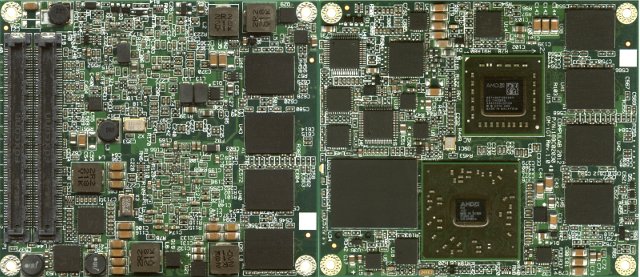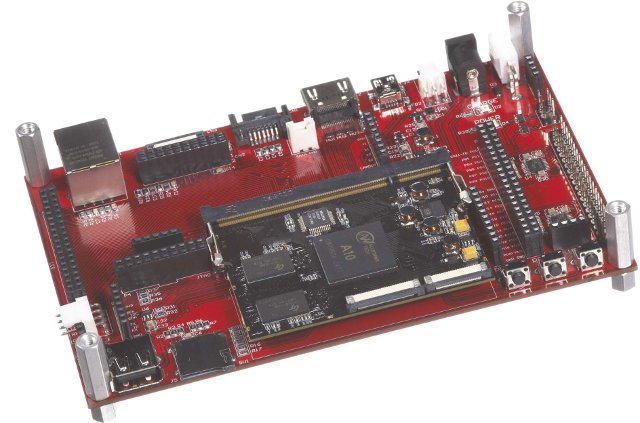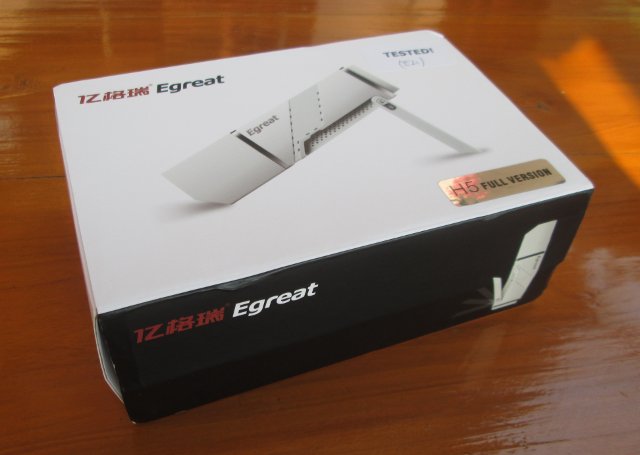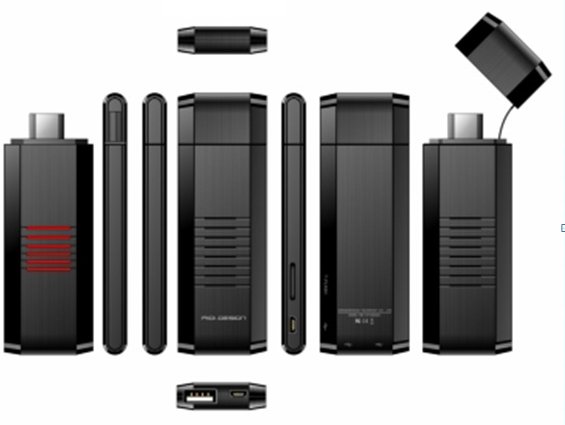ARMBRIX Zero (renamed to OPENBRIX Zero), the cheapest ARM Cortex A15 board that was supposed to hit the market next month, won’t be produced anymore. Howchip has published a laconic notice to explain the cancellation: Dear Customers Due to a situation experienced by the ARMBRIX Company(www.armbrix.com), the production of its boards have been discontinued. At this time we ask for the understanding of our customers who have shared interest in the ARMBRIX zero/OPENBRIX zero product. Every PAYPAL payment will be refunded by next week. Refunds will take 3-5 business days to process. We apologize for this inconvenience, and would like to thank every customer that has appreciated the ARMBRIX/OPENBRIX zero product. The project owner cannot provide an explanation why this has been canceled (it’s probably confidential), but still offer people to contact him if they have project ideas for the board. That means the only Cortex A15 option is now […]
$89 Compulab CM-iGT CoMs Feature AMD G-Series APUs
Compulab, an Israeli company specialized in embedded computing, has recently introduced computers-on-module based on AMD G-Series APUs that will sell for as low as $89 per unit (for 1k orders) depending on selected features and options. The module is available in commercial, extended and industrial grades, and supports up to 4GB RAM, and 32 GB Flash. Here are the specifications of these modules: CPU – AMD G-Series Processor: G-T16R single-core @ 600MHz, G-T40E dual-core @ 1GHz or G-T56N dual-core @ 1.65GHz GPU – Integrated GPU Radeon HD 6250 supporting the following standards: DirectX 11, OpenGL 4.0, OpenCL Video Processing Unit – UVD 3 engine with native H.264, VC-1, MPEG2, and DivX, 1080p Blu-Ray playback support System Memory – 2GB – 4GB DDR3-1066, 64-bit Storage: On-board BIOS flash, 1MB, reprogrammable On-board SSD, up to 32GB, MLC, through SATA interface Interfaces: Display – Up to two DisplayPort interfaces, up to two HDMI […]
BDD Group Announces AllWinner A10 Computer-on-Module
BDD Group (Black Dragon Development Group), a US based technology startup, has recently announced an AllWinner A10 Computer-on Module (CoM) targeting the industrial embedded market with support for Linux, Android and WinCE operating systems. The company did not provide complete specifications for the CoM/SoM, and they basically listed A10 specifications and added an RTC: SoC – AllWinner A10 ARM Cortex-A8 CPU + Mali-400 GPU VPU – Support for 2160P video decoding, 3D video decoding, various codecs such as VP8, AVS, H. 264 MVC, VC-1, MPEG-1,2,4, etc, and H.264 HP video encoding up to 1080p @ 30 fps or dual-channel 720p @ 30 fps. Display Multi-channel HD display Integrated HDMI 1.4 YPbPr, CVBS, VGA Multiple LCD interfaces, including CPU, RGB, LVDS up to Full HD Memory 32-bit DDR2/DDR3 up to 2GB SLC/MLC/TLC/DDR NAND up to 64 GB Boot Devices – NAND Flash, SPI NOR Flash, SD Card,USB RTC – Real time […]
Ittiam HEVC Decoder To Provide H.265 Video Decoding for Existing ARM Cortex-A Devices
H.264 is now the favorite codec for many applications, and all ARM SoC providing multimedia capabilities support it. However, a new codec called H.265 (aka HEVC) is coming with twice the compression ratio with the same quality saving a lot of money for those who have to pay for the bandwidth. The transition between video codecs is normally a slow process, but as it happens you may wonder if you’ll be able to play H.265 videos on your existing ARM Cortex A9/A15 devices which do not support H.265 hardware video decoding. The answer appears to be “Yes You Can!”, as Ittiam Systems announced an HEVC decoder specifically designed for ARM Cortex A processors. More specifically their software decoder will support: ARMv7 Cores with NEON – Cortex A8, Cortex A5, Cortex A9, Cortex A15, Cortex A7 and the multi core variants Qualcomm Snapdragon APQ8064/MPQ8064 , MSM8960 Ittiam HEVC decoder mainly targets devices such […]
Giayee TV BOX101 Looks Like a Nexus Q Clone
Last summer Google launched the Nexus Q a set-top box which main features were its rounded shape and ridiculously high price. Google eventually dropped the product, but at least one Chinese company called Giayee believes in the concept and launched TV BOX101 which just looks like the Nexus Q internally, but instead of OMAP4460, it’s powered by Rockchip RK3066. Here are some preliminary specifications of the device: SoC – Rockchip RK3066 Dual core A9 @ 1.6GHz + Quad Mali-400 GPU System Memory 1G DDR3 RAM Storage – 8G NAND Flash + micro SD slot Video Out – HDMI + AV Connectivity: Ethernet – 10/100M Wifi – 802.11 b/g/n USB – 2x USB Host Size – Diameter 117mm, Height 108.5mm Weight: 363g Air Mouse Control Wireless Microphone Somatic Joypad Customized UI This Android 4.1 device will come with an “Air Mouse Controller”, an HDMI cable, a power supply (5V/3A), and a […]
Latest Tronsmart Prometheus Firmware Features Android 4.2 and XBMC with Video Hardware Decoding
Last month I reviewed Tronsmart Prometheus, and I was pretty satisfied with the device except some bugs. There’s no a firmware update that should fix AC3/DTS static noise issues in this set-top box. Prometheus also becomes one of the first set-top boxes to support the latest Android Jelly Bean 4.2, and comes with an XBMC version supporting hardware decode using XBMC user interface, and not an external media player such as DicePlayer or MX Player. You can download the firmware ( 2013-3-08(4.2_root_ac3_dts_market_xbmc).zip), and install it using the upgrade procedure on Tronsmart website. I’m on the road, so I can’t try the firmware myself right now (which also explains why I haven’t posted in the last few days), but Geekuying has upload a short video showing XBMC with video hardware acceleration on the device. (Previous firmware in Android 4.1.2). Jean-Luc Aufranc (CNXSoft)Jean-Luc started CNX Software in 2010 as a part-time endeavor, […]
Review of Egreat H5 mini PC Powered by Nufront NS115
W2COMP sent me a new toy to play with: Egreat H5 mini PC built around Nufront NS115 dual core Cortex A9 SoC with 1GB RAM and 4GB Flash, and (theoretically) running Android Jelly Bean (4.1). Since it’s the first time I write about this device, let’s start with the specifications as shown in W2COMP: SoC – Nufront NS115 dual core Cortex A9 @ 1.0GHz + Mali-400 GPU System Memory – 1GB DDR3 Storage – 4GB Nand Flash (2 GB for OS, 2GB available space) + micro SD slot. Video Output – HDMI (720p / 180p) Video Containers- AVI, RMVB, MKV& FLV Audio Codec – Dolby, DTS, Dolby Digital Plus, Dolby True HD, PCM (DTS-HD MA, RAW not supported), MP3, WMA, AAC, FLAC and OGG Connectivity – Built-in WI-FI 802.11 b/g/n USB – 1x USB host port, 1x micro USB Misc – 1 IR port Power – 5V/2A Dimensions – 122 […]
CloudnetGo CR9 is an HDMI TV Stick Based on Rockchip RK3188 Quad Core SoC
Rockchip RK3066 based mini PCs are clearly the most popular in the market, and after the discovery of one AllWinner A20 HDMI dongle, and one AllWinner A31 mini PC earlier this week, it’s time for the first mini PC based on Rockchip R3188 quad core Cortex A9 processor called CloudnetGo CR9. Here are ClounetGo CR9 specifications: SoC – Rockchip RK3188 quad core Cortex A9 @ 1.8Ghz + Mali-400MP4 GPU System Memory – 2GB DDR3 Storage – 8 to 16GB internal flash + micro SD slot (up to 32GB) Connectivity – Wi-Fi 802.11 b/g/n Video Output – HDMI (male) up to 2160p Video Codecs – VP8, AVS, MJPEG, RV8/9/10, H.263, H.264, VC-1, MPEG-2, MPEG-4, DIVX Video Container Formats – AVI, RM, RMVB, PMP, FLV, MP4, M4V, VOB, WMV, 3GP, MKV, ASF, 3G2M4V. Audio Codecs/Formats – MP1/2/3, WMA, OGG, AAC, M4A, FLAC, APE, AMR, RA, WAV. USB – 1x USB Host 2.0, […]








